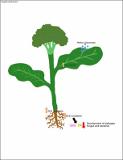Por favor, use este identificador para citar o enlazar a este item:
http://hdl.handle.net/10261/251055COMPARTIR / EXPORTAR:
 SHARE SHARE
 CORE
BASE CORE
BASE
|
|
| Visualizar otros formatos: MARC | Dublin Core | RDF | ORE | MODS | METS | DIDL | DATACITE | |

| Título: | Influence of foliar Methyl-jasmonate biostimulation on exudation of glucosinolates and their effect on root pathogens of broccoli plants under salinity condition |
Autor: | Ríos Ruiz, Juan José CSIC ORCID; Pascual, J. A. CSIC ORCID; Guillén, M.; López-Martínez, A.; Carvajal, Micaela CSIC ORCID | Palabras clave: | Biostimulation Exudate Glucosinolates Isothiocyanates plant pathogens Salinity |
Fecha de publicación: | 10-may-2021 | Editor: | Elsevier BV | Citación: | Scientia Horticulturae 282: 110027 (2021) | Resumen: | The rhizosphere is the closest area of soil around plant roots. Root exudates are the main plant factor responsible for changes in microbial communities. As brassica plants have a defence system based on secondary metabolites such as glucosinolates (GLS) and isothiocyanates (ITC), the aim of this study was to determine the root exudation of these metabolites by broccoli plants and the influence of elicitors on this process. Also, the effect of these exudates on plant pathogens Fusarium oxysporum, Pseudomonas syringae and Sphingomonas suberifaciens. Broccoli plants were grown under controlled conditions. Biostimulation treatment with methyl-jasmonate (MeJA) with/without NaCl conditions were applied. The glucosinolates and isothiocyanates were measured in the leaves, roots and growth solution. Also, these compounds present in the exudates were applied to cultures of pathogens to check the effect on their growth. The results indicate that broccoli plants exude both GLS and ITC, and that foliar application of MeJA has a systematic positive effect, enhancing their biosynthesis and exudation by root cells, however, the biostimulation produced a less plant growth under salinity conditions. The intact GLS plus the ITC detected in the growth solution showed a strong effect against the pathogens F. oxysporum, P. syringae, S. suberifaciens, providing the first evidence of their suppression to be implemented under agronomical conditions. | Versión del editor: | http://dx.doi.org/10.1016/j.scienta.2021.110027 | URI: | http://hdl.handle.net/10261/251055 | DOI: | 10.1016/j.scienta.2021.110027 | Identificadores: | doi: 10.1016/j.scienta.2021.110027 issn: 0304-4238 |
| Aparece en las colecciones: | (CEBAS) Artículos |
Ficheros en este ítem:
| Fichero | Descripción | Tamaño | Formato | |
|---|---|---|---|---|
| Rios2021SciHort.pdf | 993,91 kB | Adobe PDF |  Visualizar/Abrir |
CORE Recommender
SCOPUSTM
Citations
6
checked on 29-abr-2024
WEB OF SCIENCETM
Citations
5
checked on 29-feb-2024
Page view(s)
62
checked on 30-abr-2024
Download(s)
48
checked on 30-abr-2024
Google ScholarTM
Check
Altmetric
Altmetric
Este item está licenciado bajo una Licencia Creative Commons

